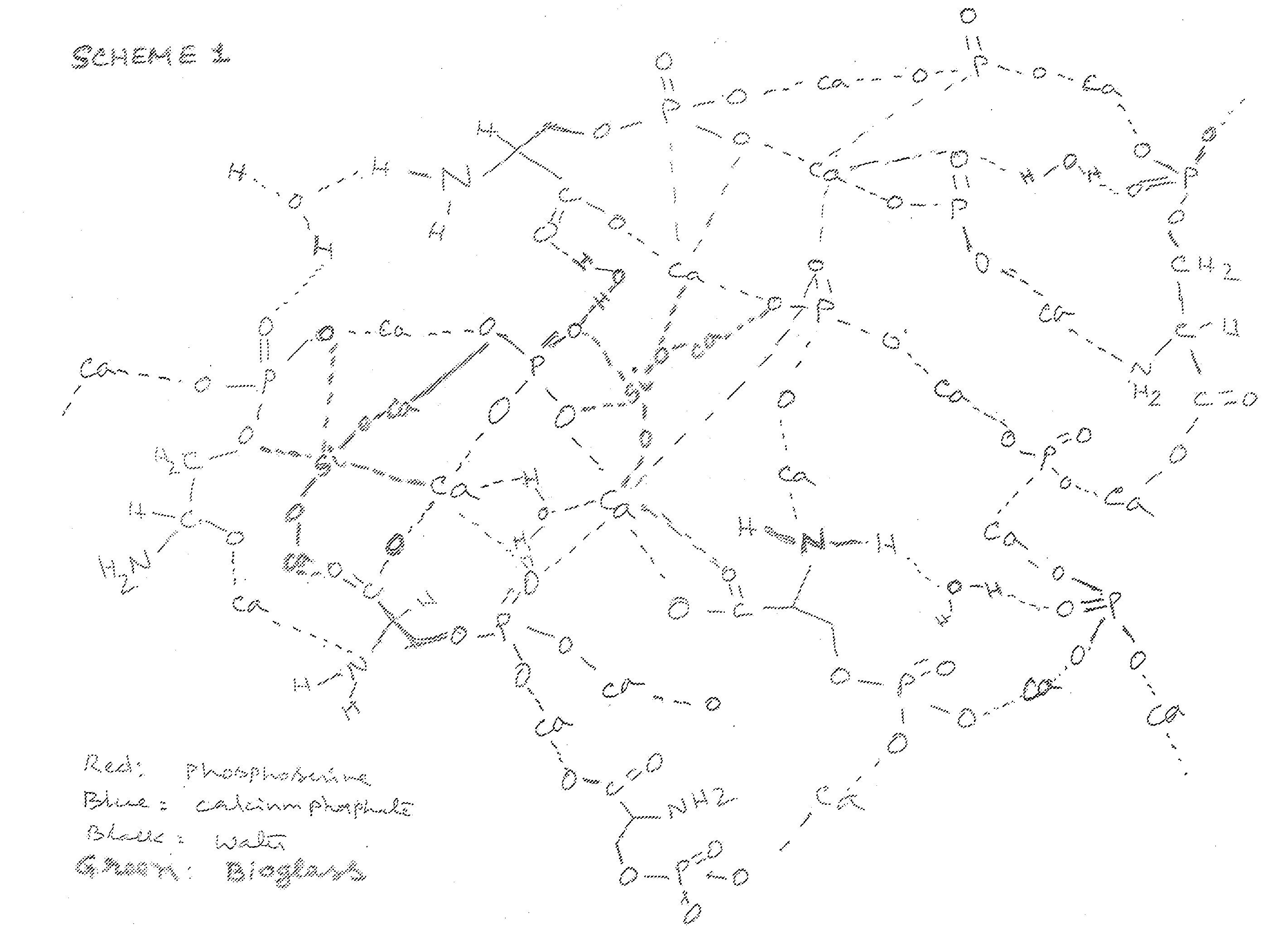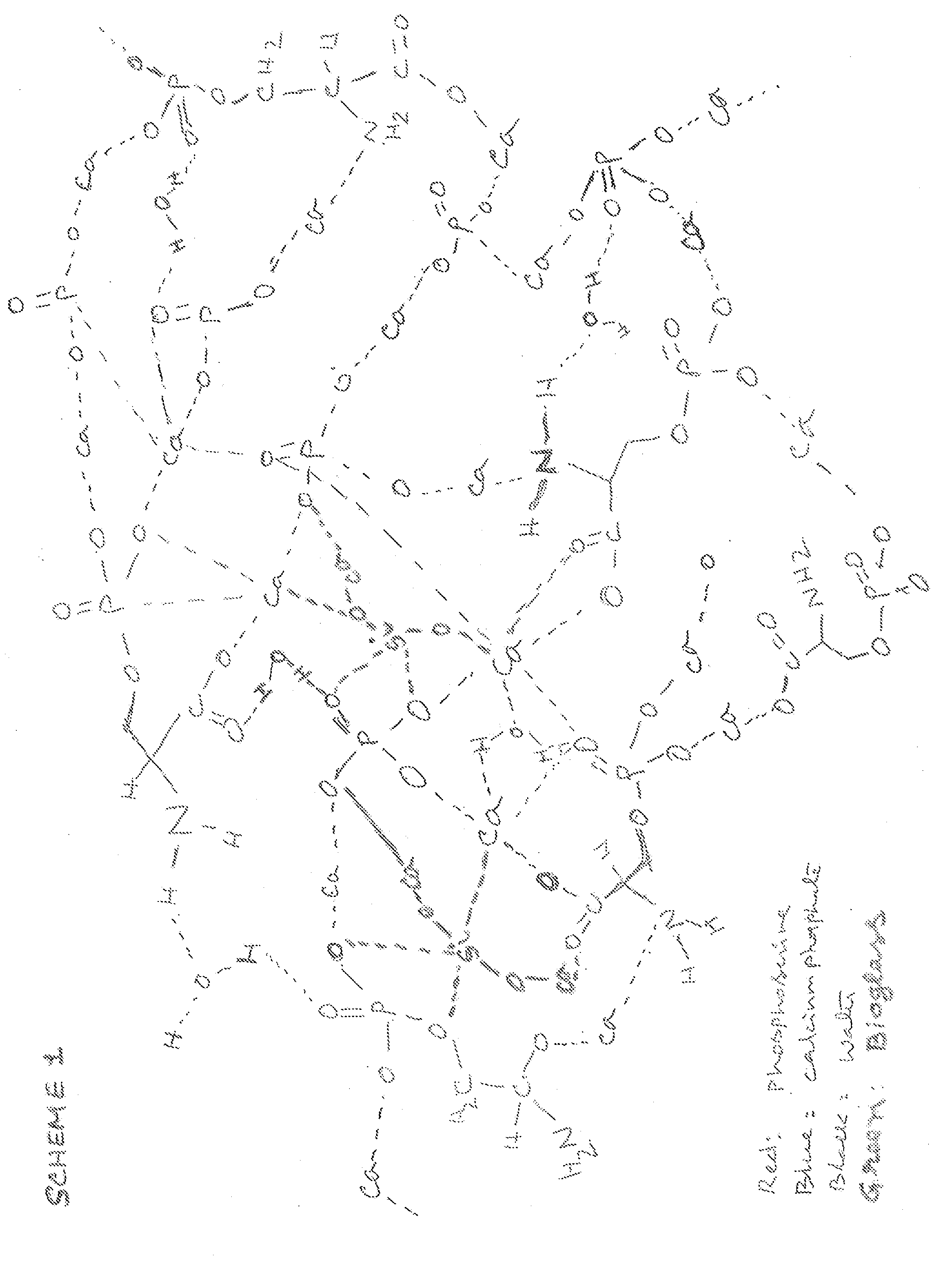Organophosphorous, Multivalent Metal Compounds, and Bioactive Glass Material Macromolecular Network Compositions and Methods
a bioactive glass and multivalent metal technology, applied in the field of calcium phosphate cements, can solve the problems of insufficient chemical interaction between calcium phosphate composite and bone surface or other surface materials, lack of sufficient adhesive strength to adhere or fix bones, and insufficient strength to be used to attach bone to bone or bone to other materials
- Summary
- Abstract
- Description
- Claims
- Application Information
AI Technical Summary
Benefits of technology
Problems solved by technology
Method used
Image
Examples
examples 1-42
[0079]In Table 1, the shear testing was done using an Instron Force test machine (Model #5564) setup as follows. The sample was supported and fastened to the machine at one end of the sample and the other end was left free and unsupported. Each sample had a bond surface that was 90 to the face of the bone samples. The force test probe was placed in plane against the top of the bond line of the sample and force was applied until failure. When the bond failed, the result was recorded. The TTCP that was used in Examples 1-12 was a commercially available material that included from about 17% to 32% of related impurities. These materials all contained about 68% to 83% TTCP.
[0080]In order to see the effect on the intrinsic material strength, bioactive glass material was added to the compositions to form a macromolecular network. Referring to Table 1, a cement formulation having the following formulation: 1.6 g TTCP, 1 g Phosphoserine, and various amounts of bioactive glass and water was m...
examples 13-16
[0082]In certain embodiments of the present invention, certain small molecule amino acid phosphate compounds such as phosphoserine, having a phosphate group (PO4), a carboxyl group (COOH), and an amine group (NH2), form ionic interactions with available metal ions. As shown in Table 2, these metal ions may be provided via the use of various calcium salts and calcium-based materials including CaO, CaCl2 or Ca(OH)2, Table 2 shows certain non-limiting formulations that may be used in the present invention,
TABLE 2Cortical Bone to Bone Shear Strength of Calcium-BasedMaterials / Phosphoserine with Bioactive Glass By WeightCombeitePhospho-BioactiveCalciumserineGlass 90-710WaterEx.Salt(g)microns (g)(ml)Material Property13011.60.528Forms sticky mass,but didn't cure14Ca(OH)2,11.60.528Forms sticky mass,140 mgand cured by itself15Ca(OH)2,11.60.6Forms sticky mass,240 mgputty and cured byitself16CaCl2,11.60.6Forms sticky mass,240 mgputty and cured byitself
[0083]In these formulations, the phosphoser...
example 17
[0084]In a further example utilizing a calcium-based material, 0.040 g CaO was mixed with 1 g Phosphoserine, 1.6 g Combeite (90-710 microns), and 0.528 mL water. The formulation formed a sticky putty that cured into a solid mass with potential load bearing applications. The strength testing of Example 17 was performed in accordance with Examples 1-12 above, Example 17 had a shear strength of 0.21 MPa.
[0085]The formulations of Examples 13-47 are most suitable for use as bone void fillers, bone graft materials and in other orthopedic applications with minimum load bearing requirements.
PUM
| Property | Measurement | Unit |
|---|---|---|
| mean particle size | aaaaa | aaaaa |
| mean particle size | aaaaa | aaaaa |
| mean particle size | aaaaa | aaaaa |
Abstract
Description
Claims
Application Information
 Login to View More
Login to View More - R&D
- Intellectual Property
- Life Sciences
- Materials
- Tech Scout
- Unparalleled Data Quality
- Higher Quality Content
- 60% Fewer Hallucinations
Browse by: Latest US Patents, China's latest patents, Technical Efficacy Thesaurus, Application Domain, Technology Topic, Popular Technical Reports.
© 2025 PatSnap. All rights reserved.Legal|Privacy policy|Modern Slavery Act Transparency Statement|Sitemap|About US| Contact US: help@patsnap.com



